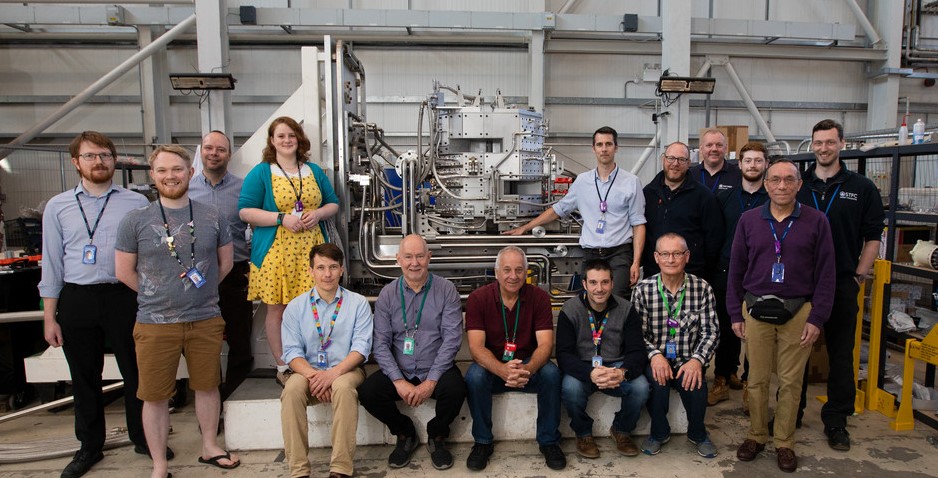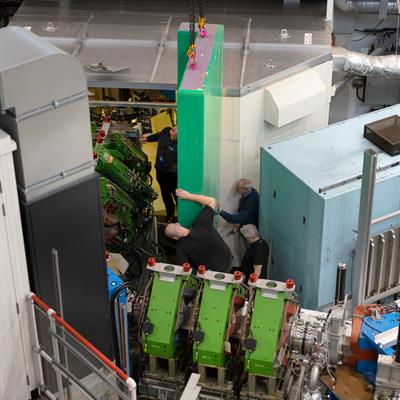ISIS' Target Station 1 has been in a long shutdown since June 2021, to allow for some major engineering projects to take place. These include the TS1 project, which saw the removal and replacement of the target, moderators and surrounding assembly, and the significant upgrade of a number of neutron and muon beamlines.

As the projects near completion, the beam will be directed back to TS1 for commissioning of the target and instruments to take place. As well as the team working on the TS1 Project itself (some of whom are pictured above) there are many other groups of people who need to work together to bring the target station back to operations. We speak to some of the teams involved in preparing for this and how they ensure the instruments become safe and operational as quickly as possible.
During a shutdown, the ISIS beamlines switch from being officially managed by the beamline scientists to being the control of the Operations Team. The routine of returning the beamlines to the scientists after a short shutdown is relatively straightforward, involving some mechanical and electrical safety checks to ensure the shutters and interlocks are working correctly. However, after such a long shutdown, things are a bit different. Some beamlines have had a considerable amount of work done on them, which means they will need additional radiological checks to ensure the new setup and shielding is safe.
The usual checks might also take longer. In the same way the mechanical and electrical workings of your car might not work after 18 months of being off, the beamlines at ISIS are the same. Although, in a lot of TS1 cases, probably a lot older than your car! In the past, large engineering projects have changed the weight distribution in the target stations, leading to the floor levels to shift by a few mm: enough to upset some of the precision alignments in the instruments. The last few weeks before the beam returns have been busy for the Operations team. John Crawford says: “we are called to the instruments to help solve any problems that might have developed during the shutdown: our step count goes right up!"
They are also conscious of the need to document the new instrument setups accurately. Andy Nobbs explains: “when TS1 was built, computer drawings didn't exist, and most instrument plans were done on paper. We have found frequently that adjustments were made but not written down, and this can cause a nasty surprise when it comes to maintenance or replacement. We're making sure that when we close up instruments now, our model is an accurate representation of what's inside." During commissioning, the beam intensity will slowly ramp up, allowing the teams to discover any issues quickly if they arise.
 Another major project to be taking place during the long shutdown was the upgrade of the RIKEN-RAL muon beamlines. This has included the installation of 35 new power supplies, over 100 km of cabling and miles of pipework. Before the beam returns, the team have been testing as much as they can, including the magnets, water systems and the 11 new vacuum pump sets and gauges. They have also been testing the integration of the new power supplies with the IBEX software used in the instruments. As with the Operations team, they have also discovered some issues during commissioning, but have been able to fix them during the process. The final stage is to return the shielding and mezzanine floor; even this requires planning as the crane is in high demand! When the beam is back on, and the muon target back in place, they will be able to do the final tuning of the magnets and detectors.
Another major project to be taking place during the long shutdown was the upgrade of the RIKEN-RAL muon beamlines. This has included the installation of 35 new power supplies, over 100 km of cabling and miles of pipework. Before the beam returns, the team have been testing as much as they can, including the magnets, water systems and the 11 new vacuum pump sets and gauges. They have also been testing the integration of the new power supplies with the IBEX software used in the instruments. As with the Operations team, they have also discovered some issues during commissioning, but have been able to fix them during the process. The final stage is to return the shielding and mezzanine floor; even this requires planning as the crane is in high demand! When the beam is back on, and the muon target back in place, they will be able to do the final tuning of the magnets and detectors.
Unlike some of the other groups, the Ancillary Plant team's systems weren't turned off during the long shutdown. This is because they manage water flow, and many pieces of equipment require this to continue, even when they're not in use. Some of them cannot be drained, and the health risks of standing water are such that the dials were just turned down, rather than off. Even this is difficult to manage. Arron Froud explains: “the plant is designed to be operational, and we had to adjust a lot of set-points and alarms to adjust to a lower water flow rate. These will have to be re-adjusted as we prepare for the beam to return to TS1."
Every day, whether during a run cycle or a maintenance period, the team monitor the water quality in the system. This includes bacteria levels but also pressure and temperature. By tracking these measurements by uploading them online, they're able to find any issues in the system, including leaks. This means that, even when circulating up to 150,000 litres of water every day, they can spot when a few litres go missing because of a broken pipe. The team of 14 are looking for ways to reduce their power consumption, balancing the desire to turn off equipment when it's not in use with the damage that could be done if the water supply is stopped.
As the long shutdown comes to an end, the team have had to make sure that the new pipework from the instrument upgrades and the TS1 project is integrated into the existing system. One new piece of equipment required a higher water flow for cooling than was expected and required a quick re-design to ensure it could operate safely with the connections available. In other areas, leaks were discovered when shielding had been returned slightly out of its original position. This type of problem solving is common for the team, who have replacement pumps and other equipment on standby for a quick installation if something goes wrong when ISIS is running.
